Trees: What is Your Tree Worth?
Part 1 - Introduction to the Valuation of Landscape Plants
By William M. Fountain and Ellen V. Crocker
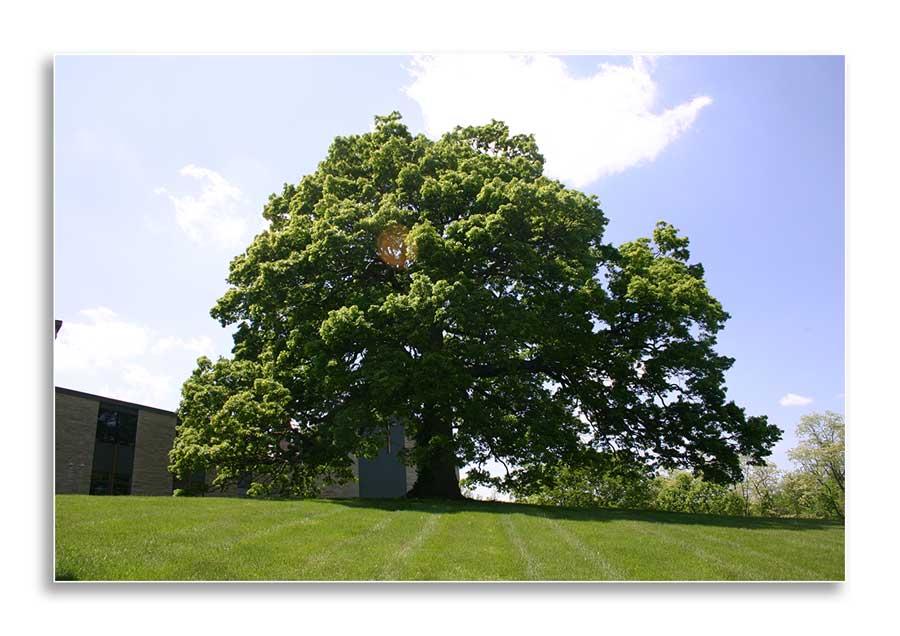
Trees provide numerous environmental, economic, and even health benefits to city residents. However, it can be difficult for homeowners to assess the value of individual trees or landscape plantings and to budget for the costs associated with their care. To help shed light on this issue, this three part series, “What is Your Tree Worth?” will introduce key concepts in assessing the value of landscape plants as well as the costs associated with repairing, maintaining, and improving their health.
Your trees are valuable
Trees in urban and suburban environments offer many benefits to citizens and landowners. Although some of these benefits are intangible, like the enjoyment of a cool summer breeze and or the relaxing sound of wildlife in the landscape, all have monetary values that can be calculated. For example:
- Trees and landscape plantings greatly impact property values. Good landscape designs can increase property values 4-5%. On the other hand, poorly placed or selected plant material can lower property values by 8-10%. Real estate assessors recognize that a house on a lot with trees or in a neighborhood with mature trees is up to 20% more saleable.
- Street trees in urban business districts lead to higher retail sales by changing consumers’ shopping patterns. Shoppers are willing to pay more and are more likely to shop longer in tree-lined areas.
- Attractive, tree-filled landscapes improve human health in cities. They reduce blood pressure, improve emotional and psychological health, provide sun protection, and reduce exposure to airborne pollutants.
- Urban trees make for safer cities. Trees reduce traffic speeds and create safer pedestrian walkways. In addition, communities with an extensive urban forest have lower crime rates.
- Trees provide many valuable environmental benefits to urban communities. They can decrease heating and cooling costs in homes and offices, sequester carbon dioxide, mitigate ozone and other pollutants, and even reduce stormwater runoff.
As a homeowner you may recognize these many benefits and work towards maintaining and improving trees and landscape plantings on your property. However, even with the best care, your valuable trees and landscape plants may be damaged through no fault of your own. In these cases, landscape appraisers may be called on to assess individual plants and entire landscapes as a result of storms, human damage, destruction, and failure.\

What is landscape appraisal?
An appraisal is an unbiased estimate of trees or any other type of property. An accurate assessment of a tree’s value can often aid in recouping partial or complete losses from insurance companies, the Internal Revenue Service (IRS), or from another individual. Should a disagreement develop over the value of the loss, it may be necessary to litigate the disagreement in court or by arbitration, which will be based on unbiased and honest appraisals of the plant’s value by professionals.
How does landscape appraisal work?
Objectivity and professional expertise are necessary in any appraisal and the monetary value of your trees should only be calculated by an unbiased arborist trained in this discipline. When damaged by someone else, the value of your tree or shrub is probably less than what you think it should be but more than what your neighbor thinks it is worth. In an assessment, a trained individual examines the vigor and vitality of the plant or landscape, evaluating its stability, appropriateness for the site, contribution to the overall aesthetic design, and presence of insects, diseases, deadwood, or decay. Because of these many complex factors, accurate valuations must be done in-person and cannot be conducted solely with the aid of images.
Assessment techniques
There are three distinctly different techniques for assessing the value of property, including trees; a cost approach, an income approach, and a market approach. The cost approach puts a dollar value on trees and other plants grown for their landscape value. The income approach considers the value of produce and the market approach considers the increased or decreased value to a property by the presence of the plants. The most appropriate assessment method for your use will depend on the type of property affected, how the property is used and reason for its assessment, and can be determined by a landscape appraiser.
Why assess your trees?
The need to assess landscape plants may arise because of accidental damage, malicious damage, or an act of nature. Damage resulting from willful and wonton intent to cause harm may be subject to tripling of assessed values under Kentucky law however, the courts can also assess additional judgments for sentimental or historical values.
In addition, in the event of a dispute, it is essential that the assessor be able to determine the initial condition of the plant prior to the loss or damage. Because of this, baseline valuations of your property can be very helpful in preparing for unanticipated future problems.
Learning more about tree costs
The second part of this series will consider the Cost Approach for valuing single plants or a limited number of plants. Part three will look at the Cost of Repair and the Cost of Cure for damaged plants or landscapes that have been significantly altered.
This article and the subsequent two articles are not intended as and do not represent legal or arboricultural advice. They are intended solely as an overview of the process of assessing the monetary value of trees and landscape plantings. Information in these articles should not be relied upon to take the place of legal or arboricultural advice. In all issues involving property rights and trespass you are advised to consult a qualified legal professional.
Part 2 - The Cost Approach (Replacement Cost and Trunk Formula Method)
Trees provide numerous environmental, economic, and even health benefits to city residents. However, it can be difficult for homeowners to assess the value of individual trees or landscape plantings and to budget for the costs associated with their care. To help shed light on this issue, this three part series, “What is Your Tree Worth?” will introduce key concepts in assessing the value of landscape plants as well as the costs associated with repairing, maintaining, and improving their health.
How is the value of trees assessed?
There are three main assessment techniques that professionals use to determine the value of trees: the cost approach, the income approach, and the market approach. In this article we will begin to discuss the cost approach method, describing the first two types of cost approach methods: replacement cost and trunk formula. The second two cost approach methods (cost of repair and cost of cure) will be covered in the next section, Part 3, along with an explanation of the income approach and the market approach.
Cost Approach:
When assessing property values, real estate appraisers consider both the estimated cost of the land and the estimated costs of construction. The cost of depreciation is subtracted from this value to give an estimate of the current value. With landscape plants, a similar estimation is made for the cost of replacement or the calculation of the current value for plants too large to transplant. The condition of the plant, location, and species are depreciation factors.
The cost approach is sub-divided into four methods; Replacement cost method, trunk formula method, cost of repair method, and cost of cure method. Determining which method should be used can be challenging and is typically site and situation dependent. Because of this, it is often beneficial to calculate tree value or the cost of a tree loss using two or more methods. The first two cost approach methods (replacement cost and trunk formula) are covered in this section and the second two cost approach methods (cost of repair and cost of cure) are covered in the next section, Part 3.
Replacement Cost
The replacement cost method is the easiest to calculate and often most appropriate of the cost approach methods. It involves estimating the cost of finding, purchasing, transporting, and installing the largest available plant(s) of the species lost, or of a similar species. The cost of removal of the old tree and restoration of the area to its former condition is also included as expenses involved with the replacement method. These replacement plants are up to the size of the individual plant(s) lost. The cost of supplemental care necessary for newly transplanted specimens to become reestablished after transplanting is added to the cost of obtaining and installing the replacement plant(s). Supplemental costs such as insurance, fees, permits, overhead, and profit are also taken into account.
Trunk Formula Method
The trunk formula method considers the species, condition, size, and location of trees to assess their value. This method is used for trees, but not shrubs and vines, since trunk diameter is challenging to assess and less informative for these plants.
The trunk formula method is one of the most commonly used (and misused) techniques for assessing values of trees and, because of this, here we will go into greater detail about the major components of this method: 1) species factor, 2) tree condition, 3) tree size, and 4) tree location.
1) Species Factor – One component of the trunk formula method is assigning different plant species particular values to aid in estimating their worth. The rating factor for each species, determined by a committee of plant experts, takes into account the performance of landscape species in different geographic regions. Factors that influence the tree species rating in this system include:
- Climate Adaptability: heat/cold hardiness, frost tolerance, drought tolerance, storm (ice, snow, wind) tolerance.
- Growth Characteristics: tolerance to different sites, vigor, structural strength, aesthetics, life expectancy, pruning requirements, potential to be invasive.
- Soil Adaptability to structure & texture, drainage, moisture, acid/alkaline, mineral element (nutrients).
- Resistance/Tolerance to diseases, insects, air pollution
The value of a particular plant species varies with geography; the same plant (or even cultivar within a species) can score differently in different locations based on USDA hardiness zones (http://planthardiness.ars.usda.gov/). It is important to note that the rating system considers the general geographic location of the plant and not the particular condition under which a specific individual is growing.
Because the species factor rating cannot distinguish different ecological areas within a geographic region or variation within a particular plant species, keep in mind that it may not be the most accurate assessment of tree value. In addition, there are sites where growing conditions are so unfavorable (i.e. extreme pH or moisture relations) that only one or a very limited number of species can survive. Under these adverse conditions, an assessor can adjust the species-rating list.
2) Tree condition - The condition of trees or other landscape plants can be assessed by comparing their health and structural integrity before and after damage. However, trees with a high risk of failure and with the potential to cause harm should not have a valuation performed and should instead be promptly assessed by an individual qualified in performing an International Society of Arboriculture (ISA) Tree Risk Assessment®.
Factors influencing tree condition include, but are not limited to:
- Structural Integrity: Factors include broken or dead roots, raised soil, broken or dead branches, decay, codominant stems, included bark, and asymmetrical growth. With trees, structural integrity can be very important, but it is rarely an issue with shrubs and vines. Instead, these plants are generally assessed only on their health and abiotic disorders.
- Plant Health: Factors include mature size, leaf color and size, shoot elongation, and potential for failure in the future.
- Other issues including abiotic disorders, physical injuries, chemical damage, limited growing space, improper installation, and poor maintenance practices.
Taking into account these factors, a numerical system is used to assign a score for condition. To learn more, consult the Guide for Plant Appraisal (9th ed.) pg. 34-35.
3) Tree size – For assessments, the size of deciduous trees and conifers that have been limbed up is usually expressed with the height, trunk diameter and/or canopy spread. The size of shrubs and conifers, on the other hand, is usually expressed with height and canopy spread but not trunk diameter. To determine tree diameter, measurements are taken at the trunk heights listed in Table 1.
Table 1. Measuring tree diameter for different sized trees
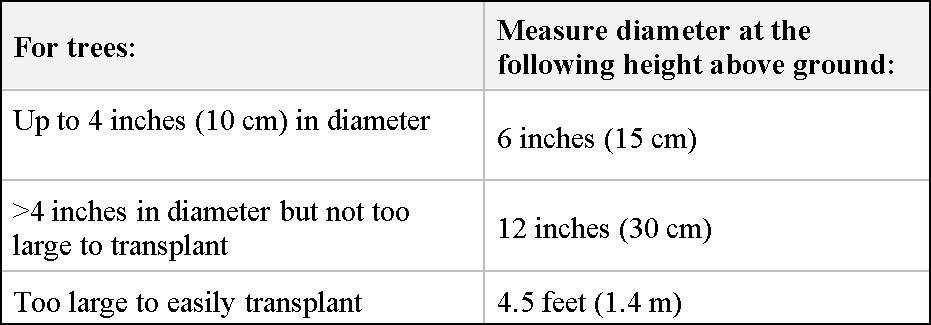
The area of the trunk is calculated by squaring the radius (half the diameter) and multiplying by Pi (3.14) but D-tapes (measuring tapes with built-in diameter calculations that can be wrapped around the tree trunk) are frequently used to obtain the diameter.
A few special considerations when measuring tree diameter:
- Trees with elliptic cross sections will have a smaller cross sectional area than trunks that are circular. Elliptic trunks must be calculated using the formula:
Area = (0.785) (largest diameter) (smallest diameter)
- If the tree is growing on a slope, the diameter is measured 4.5 feet above the point half way between the upper and lower side of the slope. (Figure 1)
\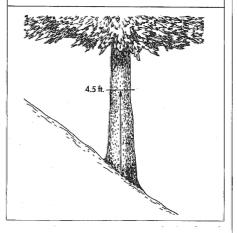
- If the tree is leaning, the diameter is measured 4.5 feet above the high point of the trunk and perpendicular to the axis of the trunk. (Figure 2)

- Branches of trees fork below 4.5 feet above the ground or are multi-stemmed (branching at the ground) are measured individually at 4.5 feet above the ground. (Figure 3 & 4) The cross-sectional area of each branch is then summed.
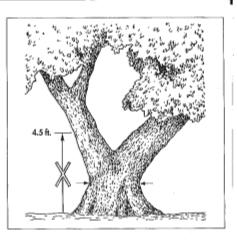
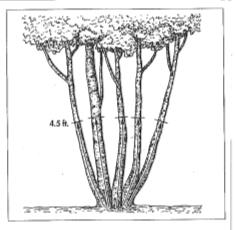
- Sometimes trees are no longer on the site and images are not available. In situations where only the stump remains, the diameter of the remaining tree can be compared to trees of the same species and similar size in the region.
- Trees reach an economic and aesthetic maturity. To prevent the annual increase in size from exceeding the contribution to the value of the landscape, an adjusted trunk area value is used for trees exceeding 30 inches (76 cm) in diameter. For more information, consult the Guide for Plant Appraisal (9th ed.) pg. 39.
4) Tree location -, Site characteristics are also important in calculating tree value. The assessor considers the contributions and placement of the tree on the property. The benefits offered by a tree to a particular location will be influenced by many factors including its size, shape, branch structure, foliage density, and association with other plants in the landscape. For example, a planting adds value by acting as a privacy screen, a wind break, a snow block, controlling dust, preventing erosion, providing wildlife habitat, or influencing energy conservation. In addition, tree placement can detract value, such as when litter from fruit becomes an issue.
The loss of a tree can depend greatly on its context. For example, the loss of a single isolated tree is more significant than the loss of a tree from a cluster. The loss of a tree placed to reduce the effect of winter winds would be more significant than an identical tree not serving this function. The loss of a tree from a fence row is less critical than if the tree had been in a managed landscape however, trees that are not in managed landscapes may also be assessed for their value as timber or firewood.
A location rating is derived by averaging a tree’s site rating, contribution rating, and placement rating. To learn more, consult the Guide for Plant Appraisal (9th ed.) pg. 54.
Calculating assessment with the trunk method
Cost per square inch is calculated by looking at the cost of the largest available tree, installed and guaranteed for 1 or 2 years. This cost is divided by the number of square inches of trunk area. For Kentucky, $50 per square inch is used as an average for ornamental trees but the assessor has the option of recalculating this.
The trunk formula is calculated by multiplying each of the following values:
- Dollar value per square inch of tree (generally $50.00)
- Number of square inches of trunk diameter
- Percent value for the species rating
- Percent value for the condition rating
- Percent value for the location rating
Trees that are considered undesirable (invasive species, messy trees, or trees with foul smelling fruit), trees in poor condition, and poorly positioned trees may actually have a negative value. For example, if a damaged tree would cost more to remove than it was worth prior to being damaged.
Keep in mind: the value assigned to a plant cannot exceed the change in sales value it represents for the property. This can become problematic when assessors assign a value to one or more plants in a landscape that is excessively high when compared to the market value of the property. Also, it should be noted that as of this writing, the IRS does not accept the trunk formula method for evaluating loss.
Part 3 - Cost Approach (Cost of Repair and Cost of Cure), Income Approach, and Market Approach
Trees provide numerous environmental, economic, and even health benefits to city residents. However, it can be difficult for homeowners to assess the value of individual trees or landscape plantings and to budget for the costs associated with their care. To help shed light on this issue, this three part series, “What is Your Tree Worth?” will introduce key concepts in assessing the value of landscape plants as well as the costs associated with repairing, maintaining, and improving their health. This article (Part 3) looks at two ways of assessing the Cost Approach and also touches on the Income Approach, and Market Approach.
Cost Approach (continued):
As previously mentioned, the cost approach depends on the various potential costs associated with tree value, care, and replacement. In Part 2, we sub-divided the cost approach into four methods; Replacement cost method, trunk formula method, cost of repair method, and cost of cure method. Here we will continue this introduction to the cost approach method and the other assessment techniques: cost of repair and cost of cure.
Cost of Repair:
The cost of repair is the third technique for calculating the Cost Approach. This method is used when trees are damaged but can be repaired. For example, this cost approach is appropriate in cases where it can be determined that, with the use of accepted industry standards (i.e. good cultural practices), the affected tree can be expected to return to a condition and appearance similar to what it was prior to the damage.
In calculating the cost of repair, any difference in appraisal between the tree’s condition before the damage and after recovery is added to the cost of all treatments prescribed for the plant to correct the damage.
Cost of Cure:
The cost of cure is the fourth technique for calculating the Cost Approach. It includes all treatments and activities necessary to return a property to a reasonable approximation of its previous condition.
The cost of cure for a property is comprehensive and may include replacement cost, trunk formula method, cost of repair, and cost of cure. This may involve debris removal and disposal, restoration of plant material, cost of repair of damaged plants, removal of competitive species, restoration of hardscape items (i.e. walks), labor, equipment, permits, licenses, and other expenses necessary to recreate the intended active or passive use of the area.
The cost of cure will depend on the type of action needed to return a property to its previous condition and, thus, can vary widely by ecosystem type and initial condition. For example, delicate ecosystems may necessitate expensive and time-consuming hand labor. On the other hand, the use of large equipment may be need for removal of debris and other tasks.
Because of the complexity of this approach, arborists, foresters, horticulturists, landscape architects, and other green industry professionals trained in plant health care are the most qualified individuals for accomplishing cost of cure assessments.
Income Approach:
The second technique used for placing a value on plants considers the potential for the damaged or destroyed plants to produce income. This is the assessment is appropriate in cases when damage that may decrease future income from the plant or its products in the future.
The income approach can be summed up by the formula:
Annual Income ÷ Rate of return = Value
Examples of sites where the income approach is the most appropriate assessment technique include production nurseries, Christmas tree farms, orchards, and timber stands. This technique is used more frequently by real estate appraisers and accountants but is less relevant to assessment by arborists or green industry professionals.
Market Approach:
The third technique, market approach, is used to compare the value of a damaged or destroyed property to similar properties. It is sometimes referred to as the Sales Comparison Approach. The courts often consider this the most reliable estimate of the real value of property because it is based on what someone else was willing to pay for a similar property.
No two properties are ever exactly identical so adjustments are allowed with the market approach. This method uses property sales to compare the estimated contribution that plants and landscapes make to the actual value of property. Because of the complexity of this approach it should only be considered with the assistance of qualified, licensed real estate appraisers.
Who should assess my trees?
The three approaches we outline here (Cost, Income, and Market) to assess the value of trees, plant material, and entire landscapes (Table 2) should only be used by individuals knowledgeable in their professions. The four subdivisions under the Cost Approach are the methods most frequently used by green industry professionals. Consult an accountant or real estate professional for the Income and Market Approach. Not all losses are covered legal deductions by the Internal Revenue Service or insurance policies. It would be prudent to consult an attorney in issues related to property law.
Table 2.

References
Currid, Peggy (ed). Guide for Plant Appraisal (9th ed). International Society of Arboriculture, Council of Tree and Landscape Appraisers. 2000.
Internal Revenue Service (US) Publication 547: Casualties, Disasters, and Thefts (https://www.irs.gov/uac/About-Publication-547)
Photography
-
Quercus alba (Dr. William M. Fountain)
- Home of Lloyd & Ashland (Dr. William M. Fountain)
- Tree on slope. (Illustration from Guide for Plant Appraisal, ISA)
- Leaning tree. (Illustration from Guide for Plant Appraisal, ISA)
- Tree branch fork below DBH. (Illustration from Guide for Plant Appraisal, ISA)
- Tree multi-stemmed branching at ground. (Illustration from Guide for Plant Appraisal, ISA)
About the Authors
Dr. William M. Fountain is an Extension Professor Emeritus of the University of Kentucky Department of Horticulture. Dr. Fountain is ISA Board Certified Master Arborist and is ISA Tree Risk Assessor Qualified. He is also a Register Consulting Arborist with the American Society of Consulting Arborists. Email at Bill.Fountain@uky.edu
Dr. Ellen Crocker is an Assistant Professor of Forest Health Extension in the Department of Forestry and Natural Resources at the University of Kentucky. Her background is in plant pathology and her current focus is on education and outreach related to forest health issues such as invasive plants, insects and pathogens. She is particularly interested in new ways to engage people about the health of their trees, including the development of the HealthyWoods app to assist landowners in assessing and improving their woods. In addition, she conducts a range of applied research related to forest health and the management of invasive species. Email @ e.crocker@uky.edu
